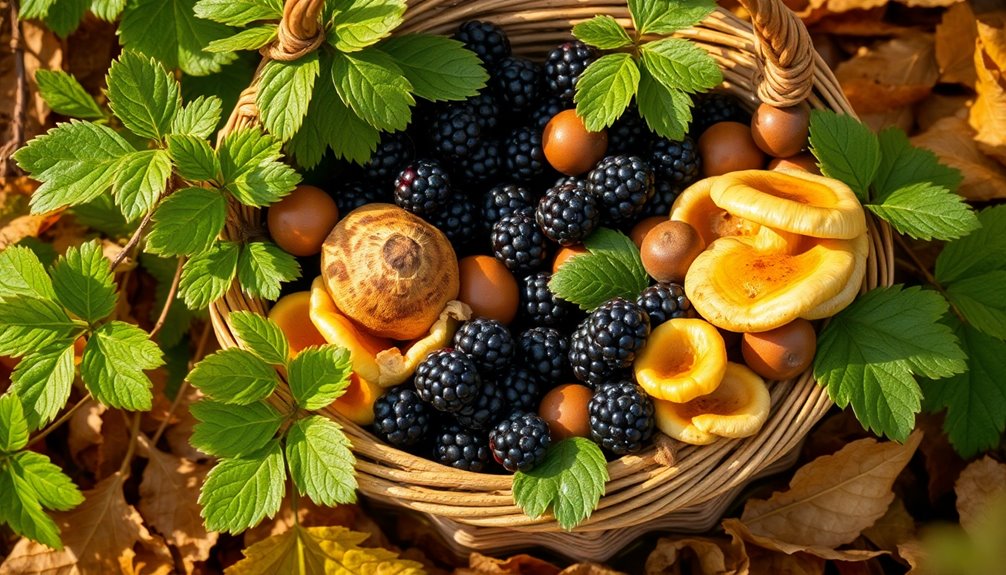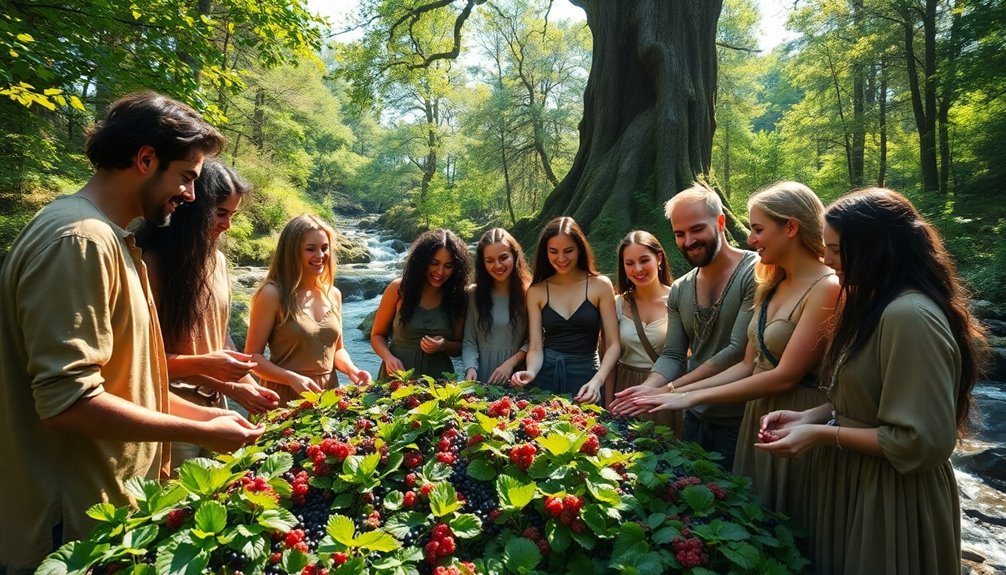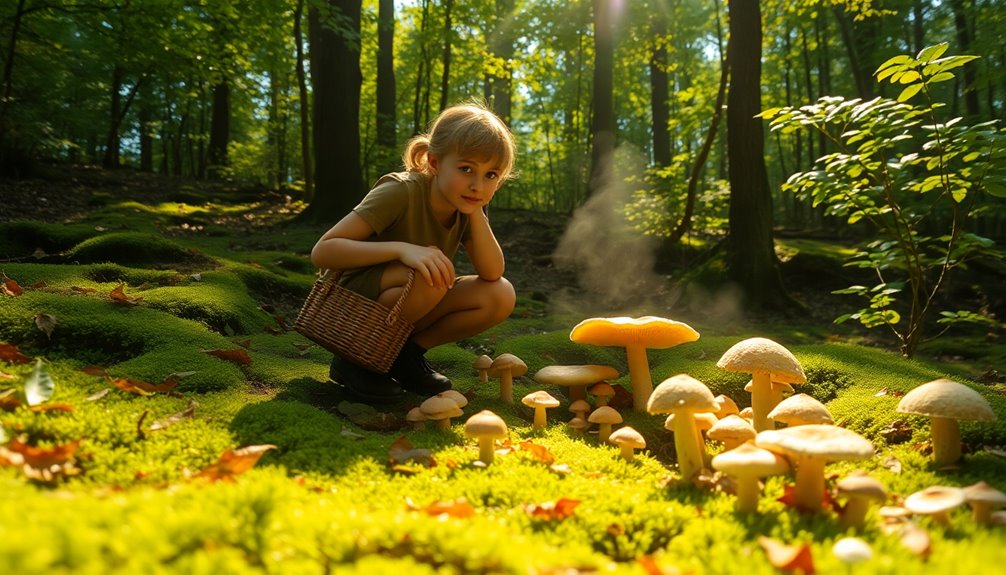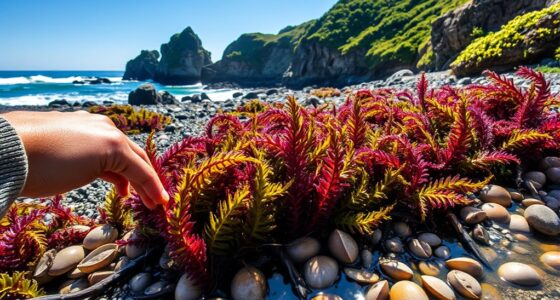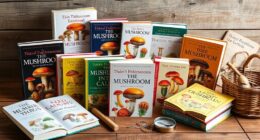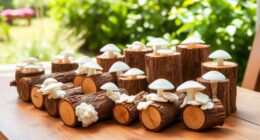In September, you can uncover a hidden autumn harvest in the UK. Start with hazelnuts, best gathered as they drop from their husks. Look for deep red hawthorn berries perfect for jams and elderberries, which can be used for wine—just avoid the toxic stalks. Don't miss out on hedgehog mushrooms, a beginner-friendly choice with a nutty flavor. For a zing, consider late-season sloes for sloe gin. Each find can enhance your cooking while supporting biodiversity. Curious about what else is out there? There's much more to explore in this seasonal bounty!
Key Takeaways
- Harvest hazelnuts in early September; collect them after they drop from their husks for the best flavor.
- Pick hawthorn berries when they are deep red in late September; ideal for making jams due to their high pectin content.
- Look for sloes after the first frost in late September; use them for making sloe gin or flavored vinegar.
- Forage for hedgehog mushrooms in September; they are beginner-friendly and serve as a flavorful meat substitute in dishes.
- Collect rosehips from September to November; rich in vitamin C, they can be used in syrups and jellies for added health benefits.
Edible Nuts and Seeds

Foraging for edible nuts and seeds in September can be a rewarding experience, especially as the hazelnut harvesting season kicks off in the UK. During the first two weeks of the month, you'll find hazelnuts ripening in their husks, ready for you to collect. These nuts can be eaten raw or roasted, with roasting enhancing their flavor, making them a delightful addition to spreads, cakes, and sweet treats.
While you're out exploring, keep an eye out for beech nuts as well. They're harvested every four to five years, and if you remove their outer brown skin, you can eat them raw. Roasting beech nuts adds a lovely depth to salads and risottos, but remember to enjoy them in moderation due to the tannins and alkaloids they contain.
Don't forget that squirrels love hazelnuts too! To increase your chances of a successful harvest, seek out trees in less accessible areas.
And while you're foraging, consider that you can also eat the leaves of some nut trees, adding an extra layer of nourishment to your early autumn foraging adventure.
Berries You Can Find

September brings a bounty of vibrant berries to the UK, perfect for your foraging adventures. While you're out exploring, keep an eye out for these delicious finds:
| Berry | Description | Harvest Time |
|---|---|---|
| Hawthorn Berries | High in pectin, ideal for jams, pick when deep red | Late September |
| Sloes | Tart fruits for sloe gin, best after frost | Late September |
| Rosehips | Rich in vitamin C, perfect for syrups and jellies | September to November |
| Elderberries | Dark red to black, great for wines, stalks are toxic | Early Autumn |
Don't forget about wild strawberries, which you can still find this month. These tiny treats can sweeten your desserts beautifully. Just remember, if you spot any berries still green, they're not quite ready yet.
Foraging can be rewarding, and knowing when to pick can make all the difference. So grab your basket, enjoy the fresh air, and embrace the hidden harvest September has to offer! Happy foraging!
Foraging for Mushrooms
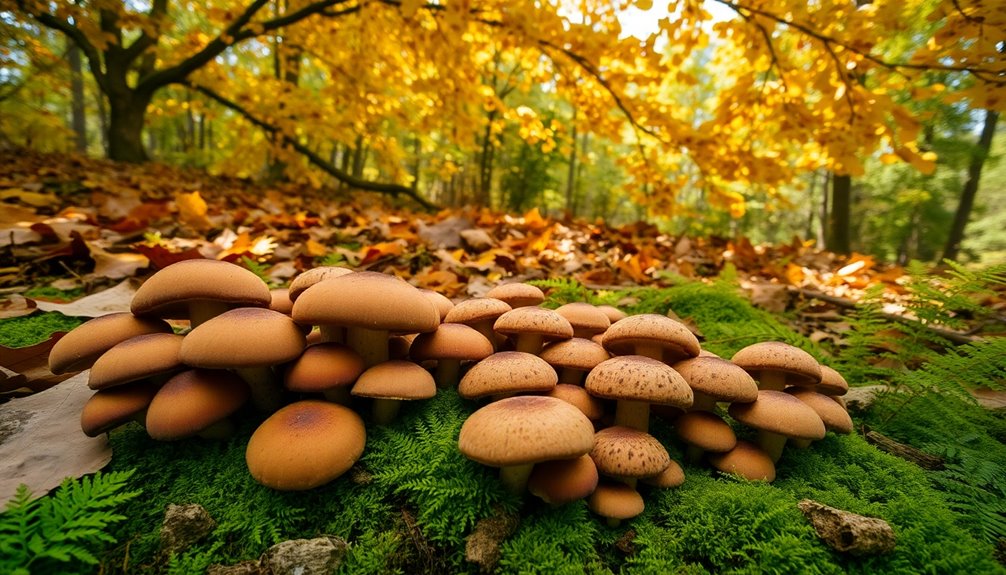
Mushroom hunting is a thrilling adventure that awaits you in the UK this month, as countless varieties become abundant in the damp woodlands. September marks the peak season for foraging, with delicious chanterelles and porcini mushrooms ready for the picking.
If you're new to foraging, start with the Hedgehog Mushroom (Hydnum repandum); its distinctive spiny underside and nutty flavor make it an excellent choice for beginners.
To guarantee the best flavor and texture, head out early in the morning when mushrooms are fresh and moist. Always carry a field guide to help you accurately identify edible mushrooms. This is vital since many species can easily be confused with toxic look-alikes.
As you forage, remember to practice sustainability. Only pick what you need and leave enough behind for the ecosystem and future growth.
This way, you'll not only enjoy your harvest but also contribute to the health of the woodland environment. So grab your basket, head into the woods, and discover the hidden gems waiting for you among the trees.
Happy foraging!
Seasonal Foraging Techniques

Often, successful foraging relies on understanding the unique characteristics of the season. In September, you'll find diverse habitats like woodlands and hedgerows teeming with edible plants and fruits. Here are some techniques to enhance your foraging experience:
| Technique | Description | Tools Required |
|---|---|---|
| Habitat Exploration | Focus on areas rich in biodiversity for better finds. | None |
| Identification | Use field guides or apps for accurate identification. | Mobile app or guide |
| Sustainable Harvesting | Take only what you need; avoid overharvesting. | None |
| Proper Tools | Use scissors or small trowels to minimize damage. | Scissors, trowel |
| Timing | Be aware of seasonal changes to find ripe fruits and mushrooms. | None |
Culinary Uses of Foraged Ingredients

When you forage for seasonal ingredients, you open up a world of culinary possibilities. Wild strawberries can elevate your desserts, while hedgehog mushrooms add depth to savory dishes. Additionally, incorporating chia seeds' health benefits into your foraged meals can enhance their nutritional value and flavor. Chia seeds are a complete protein source, making them an excellent addition to various dishes for a balanced diet. Their high fiber content also aids digestion, ensuring you can enjoy your foraged feast without discomfort. Adding omega-3 fatty acids from chia seeds can further boost heart health and overall wellness. Furthermore, considering the nutrient deficiencies that can arise from unbalanced diets can help you make informed choices about your foraged ingredients.
Seasonal Ingredient Pairings
Foraging in September opens up a treasure trove of seasonal ingredients that can elevate your culinary creations. By experimenting with these unique finds, you can add depth and flavor to your dishes.
Here's a quick guide to some fantastic pairings:
| Foraged Ingredient | Culinary Use |
|---|---|
| Wild Strawberries | Perfect for desserts like crème brûlée or panna cotta. |
| Hedgehog Mushrooms | An excellent meat substitute, enhancing savory dishes. |
| Sloes | Create homemade sloe gin or transform into jams and vinegar. |
| Hawthorn Berries | High pectin content makes them ideal for jellies and jams. |
| Rose Hips | Process into syrups for desserts and health benefits. |
Incorporating these ingredients can transform a simple meal into something extraordinary. For instance, combine hedgehog mushrooms with seasonal vegetables for a hearty dish, or drizzle rose hip syrup over pancakes for a delightful breakfast. Don't shy away from experimentation; the unique flavors of foraged ingredients can surprise and delight your palate. So, get out there and forage—your next culinary masterpiece awaits!
Creative Dessert Enhancements
September's bounty offers an exciting way to elevate your desserts with foraged ingredients.
By incorporating these unique flavors into your sweet creations, you can impress your guests and indulge your taste buds. Here are three delightful ideas to inspire your culinary adventures:
- Wild Strawberries: These tiny gems pack a punch of flavor. Use them to top panna cotta, enhancing both taste and presentation. Their vibrant color and sweetness will make your dessert pop. Additionally, their aroma can be enhanced through aromatherapy techniques to create a multi-sensory experience. The use of essential oils can further elevate the flavor profile of your dishes.
- Rosehips: Rich in vitamin C, rosehips can be transformed into a tangy syrup or jelly. Drizzle this over cakes or mix it into a filling for pastries, adding a rejuvenating contrast that brightens your dessert.
- Roasted Hazelnuts: Their nutty flavor is perfect for adding texture. Chop them up and sprinkle them over chocolate tarts or blend them into ice cream for a delightful crunch. Additionally, foraged ingredients like wild strawberries can be used to create a refreshing sauce that complements many desserts beautifully.
Identifying Hazelnuts and Sloes

As you explore the countryside in early September, keep an eye out for hazelnuts and sloes, two gems of the season. Hazelnuts (Corylus avellana) ripen in the first two weeks of September. To identify them, look for trees with long, straight branches and unique serrated leaves. Foraging in less accessible areas increases your chances since squirrels often target these tasty nuts. Wait until they drop from their husks for the best harvest.
Sloes (Prunus spinosa) are small, dark purple fruits that ripen from late September to December. They're known for their tart flavor, making them unsuitable for raw consumption. You can spot the blackthorn bush, which produces sloes, by its small, pointed leaves and distinctive black bark. These bushes often grow in hedgerows and roadside areas throughout the UK.
Here's a quick comparison to help you visualize these finds:
| Hazelnuts | Sloes |
|---|---|
| Ripen in early September | Ripen from late Sept to Dec |
| Found on straight branches | Found on blackthorn bushes |
| Sweet, great for roasting | Tart, ideal for jams and gin |
Harvesting Rosehips and Hawthorn
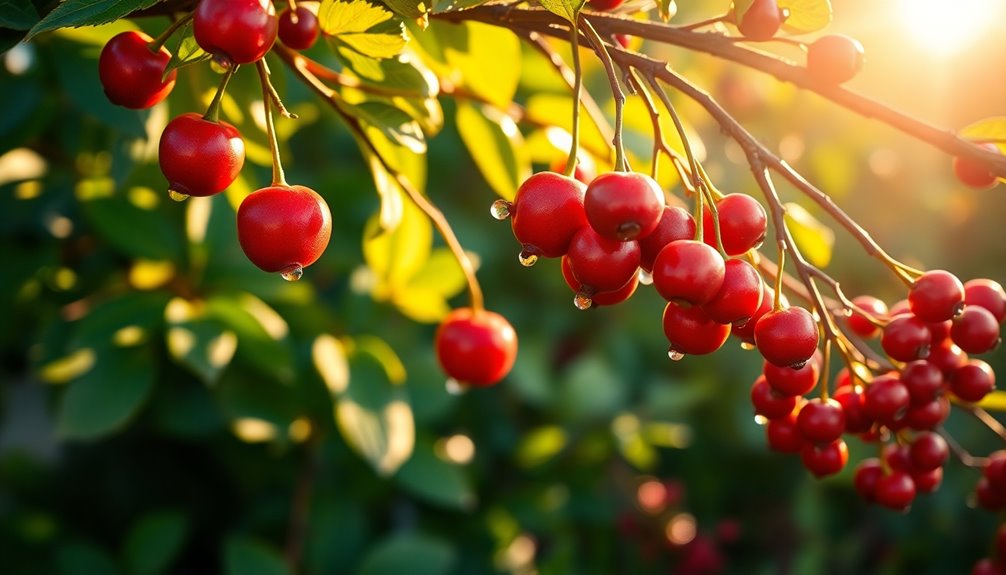
This month, you'll find rosehips and hawthorn berries reaching their peak ripeness, making it a perfect time to harvest these nutritious fruits.
Rosehips, particularly from the Dog Rose (Rosa canina), are best picked when they're a deep red. These fruits are packed with vitamin C and can be used to create delicious syrups, jellies, and even wines. Just remember, the seeds inside can be irritating, so handle them with care.
Hawthorn berries, or haws, are also ready for harvesting in September. When they turn dark red, they're ideal for making jams, jellies, and vinegar thanks to their high pectin content. While the leaves are edible in spring, save the berries for your autumn culinary delights.
Here are three tips for harvesting:
- Use Proper Tools: Invest in sharp, clean scissors or pruners to minimize damage to the plants.
- Harvest Sustainably: Only take what you need to allow plants to thrive for future seasons.
- Identify Correctly: Verify you're confident in your plant identification to avoid any toxic look-alikes.
Happy foraging!
Exploring Wild Berries
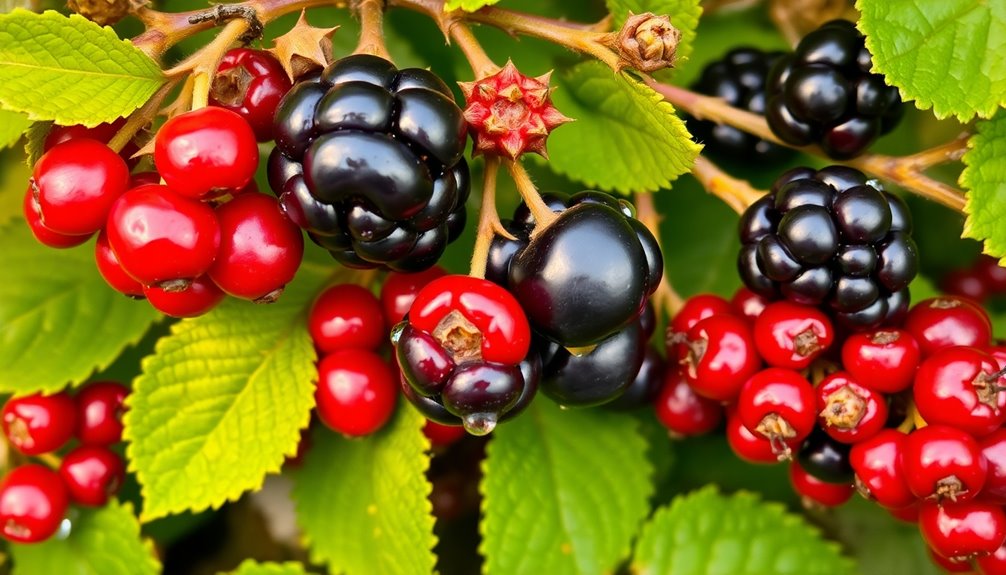
If you love the thrill of foraging, exploring the wild berries of September is a delightful adventure. This month is the peak season for hawthorn berries, which you should pick when they're deep red and ripe. Their high pectin content makes them perfect for jams and jellies.
Don't forget about rosehips from the dog rose (Rosa canina); these bright red seed pods are packed with vitamin C and are excellent for syrups and jellies.
Sloes, the tart fruits of the blackthorn, can be harvested after the first frost, but you can also collect them earlier for jams and vinegars. Their unique flavor adds a special touch to your culinary creations.
You might still find wild strawberries in September, too. Although they started appearing in July, their small, flavorful fruits can enhance your desserts, even though gathering them in large quantities can be a bit challenging.
September offers an abundance of wild berries, making it an ideal time to explore hedgerows and woodlands. So grab your basket and enjoy the bounty of nature's seasonal treats!
Sustainable Foraging Practices
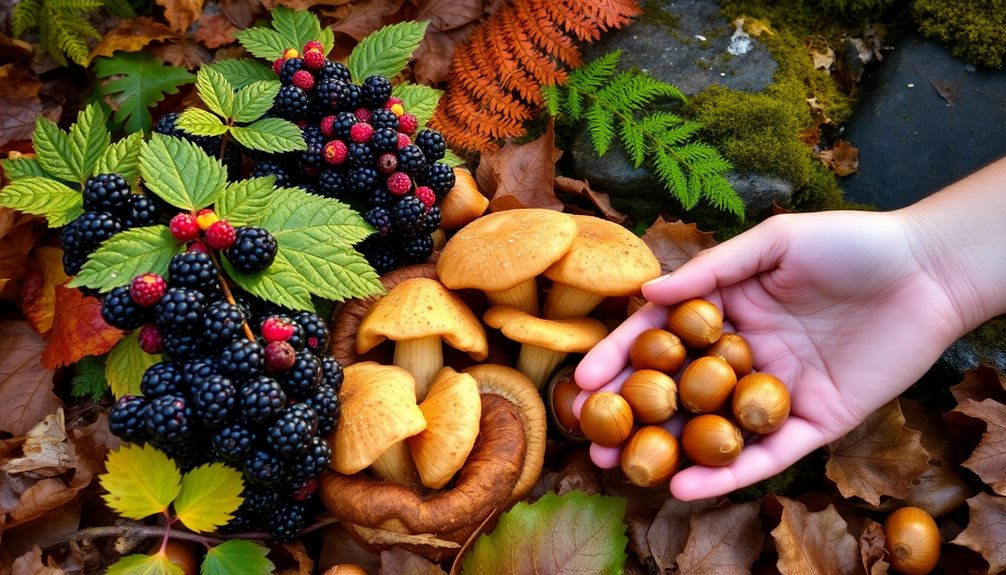
When you go foraging, it's essential to identify edible species accurately to avoid harmful plants.
Always minimize your environmental impact by following local harvesting regulations and only taking what you need.
Identify Edible Species
September's bounty invites foragers to explore the rich diversity of edible species available in the UK. This is the perfect time to venture into woodlands and hedgerows, where you can discover a variety of delicious treats.
To guarantee you're foraging safely and sustainably, use field guides or foraging apps to accurately identify what you find. Here are three edible species you should look out for:
- Hazelnuts – A nutritious snack that's great for munching on during your adventures.
- Hawthorn Berries – These bright red berries aren't only edible but can also be used in jams and jellies.
- Rose Hips – Packed with vitamin C, these can be brewed into a soothing tea.
Always double-check your identifications with multiple reliable sources to avoid toxic plants.
Remember to harvest sustainably; take only what you need and leave enough for wildlife and future growth.
By focusing on diverse habitats and employing proper tools, you can enjoy a fruitful foraging experience while helping to preserve the natural environment for years to come.
Happy foraging!
Minimize Environmental Impact
Foraging offers a wonderful chance to connect with nature and enjoy its bounty, but it's crucial to minimize your environmental impact. Always leave at least 50% of what you find behind to guarantee the plants or fruits can continue growing and reproducing. This practice helps maintain healthy ecosystems and supports future foraging opportunities.
Use proper foraging tools, like scissors or small knives, to carefully harvest. This not only minimizes damage to the plants but also protects their surrounding habitat.
When foraging, aim to explore diverse habitats. This approach helps support biodiversity and reduces pressure on any single area, fostering ecological balance.
Be mindful of local regulations regarding foraging. Educating yourself on these rules guarantees you're compliant with laws designed to protect wild flora and fauna.
Additionally, avoid foraging in polluted areas or along roadsides. Contaminants can accumulate in edible plants, compromising both their safety and the surrounding ecosystem.
Respect Harvesting Regulations
Respecting harvesting regulations is essential for sustainable foraging practices. Always check local laws before you head out; certain areas may have restrictions to protect native species and ecosystems. This guarantees that your foraging doesn't harm vulnerable plants or disturb the local wildlife.
Here are three key practices to follow:
- Only take what you can consume: Limit your foraging to what you can realistically use. This prevents overharvesting and helps maintain sustainable populations of wild plants and fungi.
- Practice the "one in, one out" rule: When foraging, consider taking one item only if you leave another behind. This allows wildlife to thrive and promotes future growth of the plants you're harvesting.
- Use the right tools: Employ proper tools and techniques to minimize damage. Confirm that essential parts of the plants, like roots, remain intact for regrowth. Additionally, ensure that your foraging practices align with air quality considerations to promote a healthier environment for both plants and wildlife.
Frequently Asked Questions
What Can You Forage in September in the UK?
In September, you can forage a variety of delicious treats in the UK. Look for ripe hazelnuts, perfect for snacking or roasting.
Hawthorn berries are abundant and can be used in jams when they're deep red. Don't forget about the sweet wild strawberries, still in season.
If you're willing to wait for frost, sloes are great for gin.
Finally, harvest rosehips for their vitamin C, ideal for syrups and jellies.
Happy foraging!
What Is the Best Book on Foraging Wild Food?
If you're ready to channel your inner hunter-gatherer, "The Forager's Calendar" by John Wright's your best bet.
It's like having a wild food GPS, guiding you month by month through the UK's edible treasures.
You'll discover what's ripe for the picking and learn how to identify plants safely.
Plus, it's packed with practical tips that'll make your foraging adventures both fun and fruitful.
Get ready to embrace the wild side of your meals!
Is It Illegal to Forage for Foliage in the UK?
Foraging for foliage in the UK isn't outright illegal, but it comes with rules.
You can forage on public land, but check local laws first. Certain protected species can't be uprooted or damaged, so you'll want to know which plants to avoid.
Always ask for permission on private land and practice responsible foraging by following the "leave no trace" principle.
Take only what you need, leaving enough for the plants to thrive.
When to Pick Bullace in the UK?
You should pick bullace in the UK from late August to early October.
Look for fruits that are slightly soft to the touch and have developed a deep color. The flavor improves after the first frost, so you might want to wait a bit for that extra sweetness.
Bullace trees are commonly found in hedgerows and woodlands, so keep an eye out for them during your autumn walks.
Enjoy them raw or use them for jams and wines!
Conclusion
As you step into the crisp September air, imagine the thrill of uncovering hidden treasures in the wild. Picture yourself savoring the rich flavors of freshly foraged hazelnuts or the tartness of ripe sloes. With each rustle of leaves, you reveal nature's bounty, but tread carefully—sustainable practices are key. Will you commence this adventure and bring home a taste of autumn? The wild is waiting, and so are the delights it has to offer.

